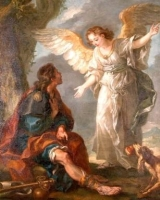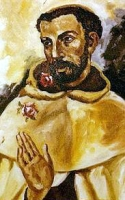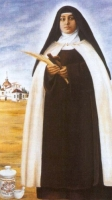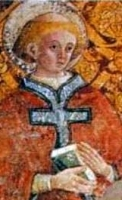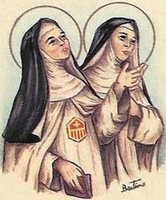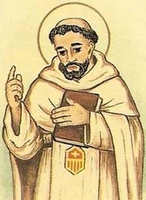Saint Stephen of Hungary
ஹங்கேரியின் புனிதர் முதலாம் ஸ்டீஃபன்
ஹங்கேரியின் அரசர்:
பிறப்பு: கி.பி. 975
எஸ்டர்காம், ஹங்கேரி
இறப்பு : ஆகஸ்டு 15, 1038,
எஸ்டர்காம், ஹங்கேரி அரசு
புனிதர் பட்டம் : 1083
திருத்தந்தை ஏழாம் கிரகோரி
பாதுகாவல்: ஹங்கேரி
நினைவுத் திருநாள் : ஆகஸ்ட் 16
புனிதர் முதலாம் ஸ்டீஃபன், கி.பி. 997ம் ஆண்டு முதல் கி.பி. 1000 அல்லது 1001ம் ஆண்டு வரையான காலத்தில் பதவியிலிருந்த ஹங்கேரியர்களின் கடைசி மகா இளவரசரும் (Grand Prince of the Hungarians), கி.பி. 1000 அல்லது 1001ம் ஆண்டு முதல், 1038ம் ஆண்டில் அவர் இறக்கும் வரை ஆட்சியிலிருந்த ஹங்கேரியின் முதல் அரசனும் (First King of Hungary) ஆவார். இவர் பிறந்தபோது, இவருக்கு பேகனிய பெயரான (Pagan name) “வஜ்க்” (Vajk) என்ற பெயர் இடப்பட்டது. இவரது திருமுழுக்கு பற்றின விவரங்கள் தெரியவில்லை. ஹங்கேரி நாட்டின் மகா இளவரசர் “கேஸா” மற்றும் “சரோல்ட்” (Grand Prince Géza and Sarolt) ஆகியோர் இவரது பெற்றோர் ஆவர். இவரது பெற்றோர் இருவருமே திருமுழுக்கு பெற்றிருப்பினும், இவர்களது குடும்ப உறுப்பினர்களில், பக்தியுள்ள கிறிஸ்தவரான முதல் உறுப்பினர் ஸ்டீஃபன் ஆவார். தூய ரோம பேரரசன் “இரண்டாம் ஹென்றியின்” (Henry II, Holy Roman Emperor) சகோதரியான “கிசேலாவை” (Gisela of Bavaria) திருமணம் செய்துகொண்டார்.
கி.பி. 997ம் ஆண்டு, தமது தந்தை இறந்ததன் பிறகு, ஆட்சி கட்டிலில் அமர்வதற்காக (Pagan warriors) என்ற படை வீரர்களின் துணை கொண்டிருந்த 'கொப்பாணி' (Koppány) என்ற தமது உறவினர்களுக்கெதிராக போராட வேண்டியிருந்தது. தமது உறவினர்களான கொப்பாணியை வென்ற ஸ்டீஃபன், திருத்தந்தை இரண்டாம் சில்வெஸ்ட்டர் (Pope Sylvester II) அவர்கள் அனுப்பிய கிரீடத்தை அணிந்து ஹங்கேரி நாட்டு மன்னராக முடிசூட்டப்பட்டார். ஹங்கேரி நாட்டின் கடைசி இளவரசரும் முதலாம் அரசரும் இவரேயாவார்.
தன் தந்தையின் மரணத்தின்பின் "மாகியர்" (Magiar) என்ற சாதியினருக்கு தலைவராக பொறுப்பேற்றார். தம் மக்களை ஆட்சி புரிவதில் நீதியும், நல்லிணக்கமும், இறைப்பற்றும் கொண்டு விளங்கினார். திருச்சபையின் சட்டதிட்டங்களை மிக நுணுக்கமாக கடைபிடித்தார். தன் நாட்டு மக்களின் நலனில் அக்கறை கொண்டு, அவர்களின் தேவைகளை நிறைவேற்றி வாழ்ந்தார்.
இவர் அமைதியின்றி தவித்த மற்ற நாடுகளுடன் தொடர்புகொண்டு, அமைதியை ஏற்படுத்தினார். தன் நாட்டு மக்களை இறையுணர்வில் வளர்த்தெடுத்தார். நாடு முழுவதும் பல புதிய மறைமாவட்டங்களையும், மூன்று பெனடிக்டின் மடாலயங்களையும் உருவாக்கினார். பல துறவற சபையினரை தன் நாட்டிற்கு வரவழைத்து, கிறிஸ்தவ விசுவாசத்தைப் பரப்பினார். பல துறவற மடங்களையும், ஆலயங்களையும் கட்டினார். தன் நாட்டு மக்கள் அனைவரும் கிறிஸ்தவர்களாக வாழ வழிவகுத்தார். கிறிஸ்தவர் அல்லாதவர்களுடன் தொடர்புகொள்வதை தடுத்தார். செபம், தவம், இவைகளில் வளர நாட்டு மக்களை துறவிகள், குருக்களின் வழியாக தூண்டினார்.
ஸ்டீஃபன் தன் நாடு முழுவதிலும் பல குருக்களையும், கன்னியர்களையும், ஆயர்களையும் உருவாக்கினார். நாடு முழுவதிலுமே திருச்சபையின் வாழ்வை பெரிதும் ஊக்கப்படுத்தி வளர்த்தார். ஹங்கேரி நாட்டில் திருச்சபை வளர அன்று இவர் இட்ட உரமானது. இன்றும் தளைத்து வளர்ந்து கிறிஸ்தவ நாடாக திகழ்கின்றது. இவரிடம் இறைவன் ஒப்படைத்த மக்களை, அவர் வழியில் நடத்தி சென்றார். தன் வாழ்நாள் முழுவதுமே தாழ்ச்சியிலும், நீதியை கடைப்பிடிப்பதிலும், அமைதியிலும் மிகச் சிறந்தவராக திகழ்ந்தார்.
கி.பி. 1038ம் ஆண்டு, ஆகஸ்ட் மாதம், 15ம் நாளன்று மரித்த ஸ்டீஃபன், “ஸ்செக்ஸ்ஃபெர்வர்” (Székesfehérvár) எனுமிடத்தில் கட்டப்பட்டு, அன்னை மரியாளுக்கு அர்ப்பணித்திருந்த பேராலயத்தில் அடக்கம் செய்யப்பட்டார். அவருடைய இறப்பு, பல தசாப்தங்களாக நீடித்த உள்நாட்டுப் போர்களை ஏற்படுத்தியது. கி.பி. 1083ம் ஆண்டில், முதலாம் ஸ்டீஃபனும், அவரது மகனான “எமெரிக்கும்” (Emeric), “க்ஸனாட்” (Csanád) மறைமாவட்டத்தின் ஆயர் “கெரார்ட்” (Gerard) ஆகிய மூவரும் திருத்தந்தை “ஏழாம் கிரகோரியால்” (Pope Gregory VII) புனிதர்களாக அருட்பொழிவு செய்விக்கப்பட்டனர். ஸ்டீஃபன், ஹங்கேரி மற்றும் அண்டை பிரதேசங்களில் பிரபலமான புனிதர் ஆவார். ஹங்கேரியில், அவருடைய நினைவுத் திருவிழா (ஆகஸ்ட் 20 அன்று கொண்டாடப்படுகிறது) மாநிலம் உருவாக்கப்பட்டதை நினைவுகூரும் ஒரு பொது விடுமுறை நாளுமாகும்.
Also known as
• Apostolic King
• Stephen the Great
• Istvan
Additional Memorial
20 August (translation of relics)
Profile
Born to a pagan family, but was baptized at age 10 with his father. King of the Magyars in Hungary. Married to Blessed Gisella of Ungarn, sister of emperor Saint Henry II. Evangelized both their peoples. Saint Astricus served as his advisor. Stephen united the Magyars into a single nation, suppressing revolts led by pagan nobles. Crowned king on Christmas Day 1001 by Emperor Otto III by authority of Pope Sylvester II. Organized dioceses, and founded monasteries. Father of Saint Emeric; brought Saint Gerard Sagredo to tutor his son.
Born
969 at Esztergom, Hungary
Died
15 August 1038 at Szekesfehervar, Hungary
Canonized
1083 by Pope Saint Gregory VII
Saint Roch
புனிதர் ஆரோக்கியநாதர்
ஒப்புரவாளர்/ யாத்திரி :
பிறப்பு: கி.பி 1348
மான்ட்பெல்லியர், மஜோர்கா இராச்சியம்
இறப்பு: ஆகஸ்ட் 16, 1376/1379
வோகெரா, சவோய் கவுண்டி
ஏற்கும் சமயம்/ சபை:
கத்தோலிக்க திருச்சபை (தூய ஃபிரான்சிஸின் மூன்றாம் வரிசை)
ஆங்கிலிக்கன் ஒன்றியம்
அக்லிபயன் திருச்சபை
புனிதர் பட்டம்:
பிரபலமான ஆர்வத்தால்; திருத்தந்தை பதினான்காம் கிரகோரி (Pope Gregory XIV) அவர்களால் "ரோமானிய தியாகவியலில்" (Roman Martyrology) சேர்க்கப்பட்டது
முக்கிய திருத்தலம்: சான் ரோகோ (San Rocco), வெனிஸ் (Venice), இத்தாலி (Italy)
நினைவுத் திருநாள்: ஆகஸ்ட் 16
பாதுகாவல்:
சர்மாடோ (Sarmato), அல்தரே இ கிரிஃபல்கோ (Altare e Girifalco), இத்தாலி (Italy). காலரா (Invoked against Cholera), தொற்றுநோய் (Epidemics), முழங்கால் பிரச்சினைகள் (Knee problems), பிளேக் (Plague), தோல் நோய்கள் (Skin diseases. மணமாகாத இளைஞர்களின் பாதுகாவலர் (Patron Saint of Bachelors), நோயுற்ற கால்நடைகள் (Diseased cattle), நாய்கள் (Dogs), பொய்யாக குற்றம் சாட்டப்பட்டவர்கள் (Falsely accused people), செல்லாதவை (Invalids), இஸ்தான்புல் (Istanbul), அறுவை சிகிச்சை நிபுணர்கள் (Surgeons), ஓடு தயாரிப்பாளர்கள் (Tile-makers), கல்லறைகள் (Gravediggers), பழைய பொருட்கள் விற்பனையாளர்கள் (Second-hand dealers), யாத்ரீகர்கள் (Pilgrims), வக்கீல்கள் (Apothecaries), கலூக்கன் ரோமன் கத்தோலிக்க மறைமாவட்டம் (Roman Catholic Diocese of Kalookan)
புனிதர் ஆரோக்கியநாதர் அல்லது புனிதர் ரோச் அல்லது புனிதர் ராக், ஒரு கிறிஸ்தவப் புனிதர் ஆவார். இவரின் விழா நாள் ஆகஸ்ட் மாதம், 16ம் நாளாகும். ஆங்கிலத்தில் இவரை ராக் என்றும் கிளாஸ்கோ என்றும்,, ஸ்காட்லாந்தில் ரோலோக்ஸ் என்றும் அழைப்பர். இவர் குறிப்பாக கறுப்புச் சாவுக்கு எதிராகப்பாதுகாவல் அளிப்பவராக நம்பப்படுகின்றார். மேலும் இவர் நாய்களுக்கும், தவறாகக்குற்றம் சாட்டப்பட்டோருக்கும் பாதுகாவலராவார்.
வாழ்க்கைச் சுருக்கம்:
இவர் மஜோர்க்கா பேரரசின் (Kingdom of Majorca) மொன்ட் பெலியரில் (Montpellier) கி.பி. சுமார் 1295ம் ஆண்டு பிறந்திருக்கக்கூடும். இவரின் தந்தை அந்த நகரின் ஆளுனராவார். இவரின் பிறப்பின்போது இவரின் மார்பில் ஒரு சிலுவை வடிவில் சிவப்பு நிற மச்சம் இருந்ததாக நம்பப்படுகின்றது. இவரின் இருபதாம் அகவைக்குள் இவரின் பெற்றோர் இருவரும் இறந்தனர். இவரின் தந்தை, தாம் இறப்பதற்கு முன், இவரை நகரின் ஆளுனராக்கினார். ஆயினும் தந்தையின் இறப்புக்குப்பின்பு தன் சொத்துக்களை விற்று ஏழைகளுக்கு அளித்தார். தனது ஆளுனர் பதவியினை தன் மாமாவுக்கு அளித்துவிட்டு இத்தாலிக்கு திருப்பயணம் மேற்கொண்டார். அச்சமயம் இத்தாலி கறுப்புச் சாவினால் பாதிக்கப்பட்டிருந்தது. அங்கே பாதிக்கப்பட்ட நோயாளிகளுக்கு இவர் பணிபுரிந்தார். பலரை அச்சமயத்தில் சிலுவை அடையாளம் வரைந்து குணமாக்கினார் என்பர். இத்தாலியினை சுற்றியுள்ள பல ஊர்களில் இவர் சேவை செய்தார்.
பியாசென்சா (Piacenza) என்னும் ஊரில் பணியாற்றியபோது இவருக்கு அந்த நோய் பிடித்தது. இதனால் இவர் ஊருக்கு வெளியே காட்டில் வனவாசியாக வாழ்ந்தார். ஒரு புதுமையால் இவரின் வசிப்பிடத்தை அறிந்த காத்ஹார்ட் (Gothard Palastrelli) என்பவர் இவருக்கு உதவினார். நலமடைந்தப்பின்னர், தன் சொந்த ஊர் திரும்பினார். அங்கே தாம் யார் என வெளிப்படுத்தாததால் அவரை ஒற்றர் என தவறாகக் கருதிய அவரின் மாமா இவரை சிறையிலடைத்தார். அச்சிறையிலேயே ஐந்தாண்டுகளுக்குப்பின்னர் இவர் இறந்தார். இவரின் மார்பில் இருந்த மச்சமும், இவரிடம் இருந்த ஒரு ஆவணமும் இவரை நகர மக்களுக்கு அடையாளம் காட்டியது. இவரின் அடக்கச்சடங்கு பொதுநிகழ்வாக நடத்தப்பட்டது. இவரின் இறப்புக்குப்பின்பு பல புதுமைகள் இவரின் பெயரால் நிகழ்ந்தன என்பர்.
கி.பி. 1414ம் ஆண்டு, காண்ஸ்தான்சு பொதுச்சங்கம் (Council of Constance) கூடியபோது பிளேக் (Plague) நோய் அந்த நகரினை தாக்கியது. அதனால் அச்சங்கத்தினர் மக்கள் அனைவரும் இவரை நோக்கி மன்றாடப்பணித்தனர். இதனால் விரைவாக நோய் நீங்கியது என்பர். 1485ம் ஆண்டு, இவரின் மீப்பொருட்கள் வெனிஸ் (Venice ) நகருக்கு கொணரப்பட்டது. அங்கேயே அவை இன்றளவும் உள்ளது.
இவர் பொதுவாக ஃபிரான்சிஸ்கன் மூன்றாம் (Third Order of Saint Francis) சபையின் உறுப்பினர் எனக்கருதப்பட்டாலும், அதனை நிருவ எவ்வகைச்சான்றும் இல்லை. உரோமை புனிதர்கள் பட்டியலில் இவரின் பெயர் திருத்தந்தை பதினான்காம் கிரகோரியால் (Pope Gregory XIV) சேர்க்கப்பட்டது. ஆகஸ்ட் மாதம், 16ம் தேதிக்கான திருப்புகழ்மாலையில் இவருக்குறியப்பகுதிக்கு அனுமதியளித்தார்.
நமது நாட்டில், தமிழ்நாடு, கேரளம், கர்நாடகா ஆகிய மாநிலங்களில் இவரது பெயரால் தேவாலயங்கள் உள்ளன
Also known as
Roc, Rocco, Roche, Rochus, Rock, Rocke, Rollock, Rollox, Roque, Seemirookie
Profile
French noble who early developed a sympathy for the poor and sick; reported to have been born with the image of a red cross on his breast. Orphaned at age 20, he gave his fortune to the poor, and became a mendicant pilgrim; may have been a Franciscan tertiary. While on pilgrimage Roch encountered an area afflicted with plague. He stayed to minister to the sick, and affected several miraculous cures, usually by making the sign of the cross over them, but contracted the plague himself. He walked into a forest to die, but was befriended by a dog. The dog fed him with food stolen from his master's table, and Roch eventually recovered.
When Roch returned to Montpellier, France, he was arrested for being a spy. He languished in jail for five years, never mentioning his noble connections, cared for by an angel until his death.
Born
1295 at Montpelier, France
Died
• 1327 at Montpelier or Angleria, France of natural causes
• relics in Venice, Italy in the church of San Rocco; in Rome, Italy; and in Arles, France
Blessed Enrique García Beltrán
Also known as
Brother Enrique of Almazora
Profile
The son of Vicente García and Donna Concepción Beltrán, Enrique was baptized on the day of his birth. As he grew, he was known as a pious child, spending all his free time in church. He entered the Seraphic Seminary of Massamagrell, Spain at age 14. Joined the Franciscan Capuchins on 13 August 1928, and made his profession on 17 September 1935. Deacon. Devoted to the study of sacred music, singing in the choir, and devotion to the canonical hours. Imprisoned and then martyred in the Spanish Civil War.
Born
16 March 1913 in Almazora, Diocese of Tortosa, Valencia, Spain
Died
• 16 August 1936 at La Pedrera on the road outside Castellón, Spain
• buried in Almazora, Diocese of Tortosa, Valencia, Spain
Beatified
11 March 2001 by Pope John Paul II
Saint Armagillus of Brittany
Also known as
Armael, Armagil, Armagilus, Armahel, Armail, Armel, Arthmael, Arthfael, Artmaglus, Arthmail, Arzel, Erme, Ermel, Ermin, Ermyn, Hermel, Thiarmail
Profile
Cousin of Saint Samson of York and Saint Cadfan. Monk. Abbot. Founded Saint-Armel-des-Boscheaux and Plou-Ermel monasteries in Brittany in coastal France. The church of Saint Erme in Cornwall in England is dedicated to him.
Born
south Wales
Died
c.550
Blessed Laurence Loricatus
Profile
Raised to be a soldier, but when he accidentally killed a man Laurence was so overcome with remorse that he put his aside his arms and made a pilgrimage of penance to Santiago de Compostella in Spain. Benedictine monk at Subiaco, Italy. Lived 34 years as a hermit in the ruins of a mountain monastery founded by Saint Benedict. Known for this austerity; if visitors left offerings, he gave them to the poor. His reputation for holiness attracted a small community of would-be spiritual students. The title loricatus because he wore a coat of chain mail next to his skin as an act of penance; the future Pope Gregory IX finally persuaded him to give it up. Wrote a book of prayers that has survived.
Born
c.1190 in Apulio, Italy
Died
• 1243 at Subiaco, Italy
• relics, including an orginal manuscript of his prayer book and his armor breastplate, enshrined at Saint Benedict's Cave at Subiaco
Beatified
1778 by Pope Pius VI (cultus confirmed)
Saint Rosa Fan Hui
Also known as
Fan Hui, Luosa
Profile
Unmarried lay woman. A convert, she took the name Rosa. She served as an active and enthusiastic catechist. When the anti–Christian forces of the Boxer Rebellion moved into the area of her village, she and her friends spent the night of the Feast of the Assumption in prayer. They were all arrested the following morning. Because she was known to be so active in her faith, Rosa was beaten and repeatedly stabbed as an example to the others; she was repeatedly ordered to renounced Christianity, and she repeatedly refused. Martyr.
Born
c.1855 in Fannjiazhuang, Apostolic Vicariate of Southeastern Zhili, Wujiao Hebei Province, China
Died
beaten and thrown into a river to drowned on 16 August 1900 in Fannjiazhuang, Apostolic Vicariate of Southeastern Zhili, Wujiao Hebei Province, China
Canonized
1 October 2000 by Pope John Paul II
Blessed Jean-Baptiste Menestrel
Profile
Priest in the diocese of Saint-Dié, France. Imprisoned on a ship in the harbor of Rochefort, France and left to die during the anti-Catholic persecutions of the French Revolution. One of the Martyrs of the Hulks of Rochefort.
Born
5 December 1748 in Serécourt, Vosges, France
Died
16 August 1794 aboard the prison ship Washington, in Rochefort, Charente-Maritime, France of infections brought on by untreated open sores
Beatified
1 October 1995 by Pope John Paul II
Blessed Angelus Agostini Mazzinghi
Profile
Carmelite in Florence, Italy. Priest. Professor of theology at Florence and Frascati, Italy. First member of the reformed observance of Our Lady of the Wood. Prior of several houses. Noted preacher. Eventually retired to the Carmelite house in Florence, and spent his last years in prayer.
Born
1377 at Florence, Italy
Died
17 August 1438 at Florence, Italy
Beatified
7 March 1761 Pope Clement XIII (cultus confirmed)
Blessed Iacobus Bunzo Gengoro
Additional Memorial
10 September as one of the 205 Martyrs of Japan
Profile
Young boy in the diocese of Fukuoka, Japan. Son of Blessed Thomas and Maria Gengoro. Member of the Confraternity of the Rosary. Martyred at the age of two in the persecutions of governor Yetsundo.
Born
1618 in Japan
Died
• 17 or 18 August 1620 in Kokura, Fukuoka, Japan having been crucified upside down soon after sunrise on 16 August
• body burned and ashes scattered
Beatified
7 May 1867 by Pope Pius IX
Blessed Simon Kiyota Bokusai
Additional Memorial
10 September as one of the 205 Martyrs of Japan
Profile
Layman catechist in the diocese of Fukuoka, Japan. Married to Blessed Magdalena Kiyota Bokusai. Member of the Confraternity of the Rosary. Martyred in the persecutions of governor Yetsundo.
Born
1559 in Kiyota, Japan
Died
• 17 or 18 August 1620 in Kokura, Fukuoka, Japan having been crucified upside down soon after sunrise on 16 August
• body burned and ashes scattered
Beatified
7 May 1867 by Pope Pius IX
Blessed Magdalena Kiyota Bokusai
Additional Memorial
10 September as one of the 205 Martyrs of Japan
Profile
Lay woman in the diocese of Fukuoka, Japan. Married to Blessed Simon Kiyota Bokusai. Member of the Confraternity of the Rosary. Martyred in the persecutions of governor Yetsundo.
Born
Kiyota, Japan
Died
• 17 or 18 August 1620 in Kokura, Fukuoka, Japan having been crucified upside down soon after sunrise on 16 August
• body burned and ashes scattered
Beatified
7 May 1867 by Pope Pius IX
Blessed Maria Gengoro
Additional Memorial
10 September as one of the 205 Martyrs of Japan
Profile
Lay woman in the diocese of Fukuoka, Japan. Married to Blessed Thomas Gengoro; mother of Blessed Iacobus. Member of the Confraternity of the Rosary. Martyred in the persecutions of governor Yetsundo.
Born
Kiyota, Japan
Died
• 17 or 18 August 1620 in Kokura, Fukuoka, Japan having been crucified upside down soon after sunrise on 16 August
• body burned and ashes scattered
Beatified
7 May 1867 by Pope Pius IX
Blessed Thomas Gengoro
Additional Memorial
10 September as one of the 205 Martyrs of Japan
Profile
Layman in the diocese of Fukuoka, Japan. Married to Blessed Maria Gengoro; father of Blessed Iacobus. Member of the Confraternity of the Rosary. Martyred in the persecutions of governor Yetsundo.
Born
Kiyota, Japan
Died
• 17 or 18 August 1620 in Kokura, Fukuoka, Japan having been crucified upside down soon after sunrise on 16 August
• body burned and ashes scattered
Beatified
7 May 1867 by Pope Pius IX
Blessed John of Saint Martha
Additional Memorials
• 22 May as one of the Franciscan Martyrs of Japan
• 10 September as one of the 205 Martyrs of Japan
Profile
Franciscan priest, ordained in 1606. Missionary to Japan where he was noted for his quick mastery of the language. Arrested at Macao in 1615, he was imprisoned for three years, then executed for his faith. Martyr.
Born
1578 at Prados, Spain
Died
beheaded in 1618
Beatified
1867 by Pope Pius IX
Saint Arsacius of Nicomedia
Also known as
Arsacio, Ursacius
Profile
Soldier in the imperial Roman army in the reign of Emperor Licinius. Convert to Christianity, which led to his arrest. Released, he lived as a hermit near Nicomedia. Miracle worker. Had the gift of prophecy; foretold the destruction of Nicomedia by an earthquake in 358.
Born
Persian
Died
• 24 August 358
• apparently died while praying
Saint Serena
Profile
Married to emperor Diocletian, and a secret Christian. Through she was certainly unable to stop the massacre of Christians, she worked to help where she could to ease their persecutions and improve their lot.
Serena has been dropped from modern martyrologies due to its questionable nature and source documents.
Died
late 3rd century
Saint Theodule of Grammont
Also known as
Theodulus, Theodore
Profile
First bishop of Valais, Switzerland, serving in the 4th century. Fought against Arianism and enshrined the relics of the Theban Legion.
Patronage
Valais, Switzerland
Blessed Ralph de la Futaye
Also known as
• Ralph de Flageio
• Radulfo, Rodolfo
Profile
Benedictine monk of Saint-Jouin-de-Marne. Helped Blessed Robert of Arbrissel found a new house. Founded the double monastery of Saint-Sulpice in 1092 in the diocese of Rennes, France, and served as its first abbot.
Died
1129
Saint Frambaldo
Also known as
Rasbaldo, Rasbaldus
Profile
Hermit and monk in the area of Cenomanian Gaul (around modern Le Mans, France).
Died
c.650 in Gaul (modern France) of natural causes
Saint Titus the Deacon
Profile
Deacon. Martyred by Goths during the sacking of Rome, he was murdered while distributing alms to starving Romans.
Died
c.410
Martyrs of Palestine
Profile
Thirty-three Christians martyred in Palestine; they are commemorated in old martyrologies, but the date and exact location have been lost.
Martyred in the Spanish Civil War
Thousands of people were murdered in the anti-Catholic persecutions of the Spanish Civil War from 1934 to 1939.
• Blessed Amadeu Monje Altés
• Blessed Antonio María Rodríguez Blanco
• Blessed José María Sanchís Mompó
• Blessed Laurentí Basil Matas • Blessed Plácido García Gilabert
Ugolina of Vercelli
The feast day of Ugolina of Vercelli is August 16. She was a virgin, anchorite, recluse, penitent, and spiritual advisor who lived in the 13th century. She is known for her story of dressing as a man and living in a hermitage for nearly 50 years in order to escape her father's plans for her to marry. She was eventually discovered and revealed her true identity, but she continued to live a life of prayer and penance until her death.
Ugolina was born in Vercelli, Italy, in around 1239. She was the daughter of a wealthy merchant. From a young age, she was devoted to God and wanted to live a life of religious seclusion. However, her father had other plans for her. He wanted her to marry and have children.
Ugolina refused to marry. She disguised herself as a man and fled to a hermitage in the mountains. She lived there for nearly 50 years, praying and fasting. She also became a spiritual advisor to many people who came to her for help.
One day, Ugolina's father came to the hermitage. He was surprised to see his daughter, but he was also impressed by her piety and dedication. He allowed her to continue living in the hermitage, and she remained there until her death in around 1300.
Ugolina was canonized by Pope Pius XII in 1950. Her feast day is celebrated on August 16.


